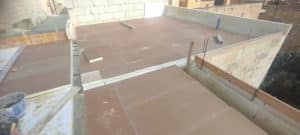Wood is a timeless material—warm, organic, and full of charm. But when it comes to durability, moisture resistance, or achieving a seamless, modern aesthetic, wood often falls short. That’s where microcement comes in.
If you’ve ever wondered can you microcement over wood, the answer is a resounding yes. In fact, applying microcement over wood is becoming an increasingly popular choice for renovations in Malta, especially in bathrooms, kitchens, and high-traffic floors. It combines beauty, performance, and practicality in one sleek solution.
In this guide, we’ll dive into everything you need to know about microcement on wood—including benefits, precautions, pricing, and whether it’s worth it for your home or commercial space. By the end, you’ll know exactly why this is one of the most innovative finishes available in the construction industry today.
1. Yes, You Can Apply Microcement Over Wood| Can You Microcement Over Wood
Let’s get straight to the point—can you microcement over wood? Absolutely, you can. With proper preparation, microcement adheres well to wooden surfaces such as:
Wooden floors
Kitchen counters
Furniture
Stairs
Plywood panels
MDF cabinets
In Malta, where humidity can affect wood over time, microcement provides a strong, waterproof barrier that increases the surface’s durability—without sacrificing style.
Why It Works
Microcement is a highly flexible material. Unlike tiles or concrete overlays that might crack when the substrate moves, microcement accommodates a certain amount of movement—making it ideal for wood, which naturally expands and contracts. The key lies in:
Correct surface priming
Use of mesh reinforcement
A high-quality microcement mix
Application by a skilled professional
Done correctly, you’ll get a surface that’s seamless, sleek, and resilient.
2. The Benefits of Microcement Over Wood Are Game-Changing| Can You Microcement Over Wood
🛠 No Demolition Required
One of the top reasons people ask can you microcement over wood is because they want to avoid tearing out existing materials. Microcement is applied directly onto wood—no demolition, no mess. It’s especially useful for:
Kitchen renovations
Vanity and cabinet updates
Modernising wooden furniture
Quick commercial fit-outs
This approach saves time, labour, and cost, making it a smart investment.
💧 Waterproof & Easy to Maintain
Wood is notoriously sensitive to water. Microcement, however, when sealed properly, becomes fully waterproof. That means:
No water damage
No warping
No mold or mildew buildup
This makes it ideal for bathroom counters, shower walls, or wooden floors exposed to spills or humidity—perfect for homes and restaurants in Malta.
💅 Ultra-Modern Look with Natural Feel
Microcement can give wooden surfaces a minimalist concrete finish—ideal for Scandinavian, industrial, or contemporary styles. Yet, it still respects the warm base layer of the wood underneath, allowing you to blend rustic with refined effortlessly.
3. What You Need to Know Before Applying Microcement on Wood| Can You Microcement Over Wood
Before diving in, let’s cover some technical must-knows. While you can microcement over wood, there are conditions:
✅ The Wood Must Be Stable
Wood can shift, warp, and swell. To reduce cracking risk, make sure:
It’s well-secured to the subfloor or wall
The surface is clean and free from oil or varnish
Movement is minimised with screws or fixings
The gaps between planks or panels are filled
If your wooden surface is too flexible, consider overlaying it with cement board or MDF first.
✅ Use the Right Primer & Mesh
To ensure perfect adhesion, you’ll need a two-step primer designed for non-porous substrates like varnished wood or MDF. Mesh (usually fibreglass) is applied after priming to absorb stress and movement.
✅ Skilled Application Is Essential
Microcement isn’t a DIY material, especially on wood. It requires:
Layered application (base coat + 2 microcement layers + sealant)
Drying time management
Skilled hand-troweling for a smooth or textured finish
At Kibitec, our team is fully trained in microcement installation—ensuring long-lasting, crack-free results even over challenging surfaces like wood.
4. How Much Does It Cost to Microcement Over Wood in Malta?| Can You Microcement Over Wood
Let’s talk euros. Applying microcement over wood is generally priced from around €65 per square metre, depending on:
Surface condition
Size of the area
Complexity of the application
Desired finish (smooth, textured, pigmented, etc.)
Here’s a rough pricing guide:
| Surface Type | Estimated Price (€/m²) | Notes |
|---|---|---|
| Flat wood floor | €65–€80 | Less prep needed |
| Cabinet surfaces | €75–€90 | Requires more detailing |
| Curved or shaped wood | €90–€110 | Higher difficulty = more labour |
| Outdoor wooden furniture | €80–€95 | Needs weather-resistant sealants |
While it may seem pricier than paint or laminate, you’re investing in a seamless, designer-grade surface that lasts years longer and resists moisture, scratches, and staining.
5. Where to Get Microcement for Wood Surfaces in Malta| Can You Microcement Over Wood
Whether you’re updating your kitchen, redoing your bathroom vanity, or transforming a rustic wooden bench, microcement opens up a whole new world of design freedom.
You can either:
Buy microcement products from us if you’re working with a contractor or know a local installer.
Book our expert service and let our trained applicators do the full installation.
In both cases, the first step is reaching out to us. We’ll assess your space and guide you through the options—no obligation.
📞 Contact us here: https://kibitec.com/contact-us/
Real-Life Applications: Where Microcement Over Wood Works Best| Can You Microcement Over Wood
Now that we’ve established that yes, you can microcement over wood, it’s worth exploring where this application works especially well. While it’s a powerful solution for many interior design projects, it’s particularly impressive in the following scenarios:
1. Wooden Furniture Makeovers
Tired of a dated wooden coffee table or dresser? Applying microcement can instantly modernise old furniture. This technique is popular in minimalist and industrial-style interiors, where smooth, concrete-like finishes replace outdated wood grains.
Microcement gives your furniture a clean, chic upgrade without the bulk and cost of buying something new. The best part? It’s customisable in colour and finish, so you’re not limited to a typical grey tone.
2. Wood Staircases
One of the most jaw-dropping uses of microcement over wood is on staircases. A wooden staircase with signs of wear, discoloration, or minor cracks can be completely transformed with microcement. When applied correctly, it not only strengthens the structure but also adds a contemporary, seamless surface from top to bottom.
Keep in mind that staircases need anti-slip finishes—fortunately, microcement systems designed for stairs incorporate non-slip aggregates for added safety.
3. Wooden Kitchen Cabinets or Worktops
In kitchens across Malta, wooden worktops and cabinets are often prone to wear from heat, spills, and heavy use. Microcement can be used to give them a new lease on life. It’s water-resistant, heat-tolerant, and easy to clean—making it ideal for practical applications in both residential and commercial kitchens.
To maintain hygiene standards, especially in food-prep areas, sealants are essential. These prevent moisture from penetrating into the microcement layer, ensuring a long-lasting and food-safe surface.
Step-by-Step: How Microcement Is Applied Over Wood| Can You Microcement Over Wood
Understanding the application process helps you appreciate the value and expertise involved. While it might look simple from the outside, the steps below highlight why hiring a professional is your best bet:
Step 1: Surface Preparation
The wood must be stable and structurally sound. Any flexing or movement must be corrected, as it can cause cracking down the line. This step includes:
Cleaning the wood of dust, oils, or old coatings
Sanding glossy finishes to allow better bonding
Sealing any joints or gaps with fibre mesh tape
Step 2: Priming the Surface
A specialised primer is used to enhance adhesion between the wood and the microcement. For example, an epoxy-based primer creates a strong bond and prevents absorption of water from the microcement mix.
Step 3: Installing a Reinforcing Mesh
In most professional applications, a fibreglass mesh is embedded into a first base coat of microcement. This ensures extra flexibility and reduces the risk of hairline cracks due to slight movement in the wood below.
Step 4: Layering Microcement
Two or more coats of microcement are applied—each carefully trowelled and left to cure. Between layers, the surface is lightly sanded to ensure smoothness and consistency.
Step 5: Sealing
The final step is sealing the surface with a polyurethane or acrylic varnish. This not only protects the finish but also enhances its resistance to moisture, stains, and UV rays. Sealing is non-negotiable when working with wood, especially in humid or high-traffic areas.
How Much Does It Cost to Apply Microcement Over Wood in Malta?| Can You Microcement Over Wood
In Malta, prices for microcement start at around €65 per square metre, and can go higher depending on the complexity of the job and the finish you choose. For wood surfaces, the additional prep work and materials may increase the price slightly.
Here’s a general idea of what you might expect:
| Application Area | Estimated Price (€/m²) | Notes |
|---|---|---|
| Furniture (tables, etc.) | €75 – €90 | Depends on size and detail of item |
| Wooden stairs | €85 – €110 | Includes anti-slip finishes and edge work |
| Kitchen surfaces | €80 – €100 | Must include food-safe sealants and high heat tolerance |
All prices include materials and professional installation. DIY kits are available, but we highly recommend professional service to ensure durability—especially since you’re dealing with wood, which is more sensitive than concrete or tile.
Why Microcement Over Wood Is a Smart Move in Malta| Can You Microcement Over Wood
Malta’s climate is Mediterranean, which means fluctuating humidity levels and salty air near coastal areas. Wood naturally absorbs moisture and can expand or contract over time. This is where microcement shines—it provides a water-resistant and durable shell over your wooden base.
Other local benefits include:
Minimal disruption: Since no demolition is required, you can keep your existing structure.
Eco-conscious choice: Instead of throwing old wooden furniture or panels away, you’re repurposing and upgrading.
Unique aesthetic: Malta’s mix of modern architecture and traditional stone buildings pairs beautifully with microcement’s neutral, organic look.
But… Is There a Catch?| Can You Microcement Over Wood
As with any material, there are some things to keep in mind before you decide to microcement over wood:
Structural stability is key – If your wooden base is weak or warped, it must be repaired or reinforced first.
Professional application is a must – DIY mistakes can result in cracks, poor adhesion, or moisture issues.
Sealant maintenance – While microcement is tough, sealants may need to be reapplied every few years, especially on high-use surfaces.
The Role of Construction Standards| Can You Microcement Over Wood
When working with composite surfaces like wood + microcement, it’s important that the techniques meet established construction quality standards. Proper layering, substrate testing, and material compatibility are key parts of the process.
Professional applicators like Kibitec are trained to follow European standards and ensure each job is not just beautiful, but built to last. Whether you’re updating a wooden staircase or covering a kitchen island, you want craftsmanship that respects the unique challenges of wood—and that’s exactly what Kibitec delivers.
Ready to Transform Your Wooden Surfaces?| Can You Microcement Over Wood
If you’ve been asking “can you microcement over wood?”, now you know—the answer is a confident yes. It’s a practical, beautiful, and long-lasting way to reinvent your space without ripping anything out.
Whether you’re a homeowner, interior designer, or builder in Malta looking for a sleek solution, microcement over wood is worth serious consideration.
👉 Get in touch with the experts at Kibitec today to learn more or request a quote: https://kibitec.com/contact-us/




